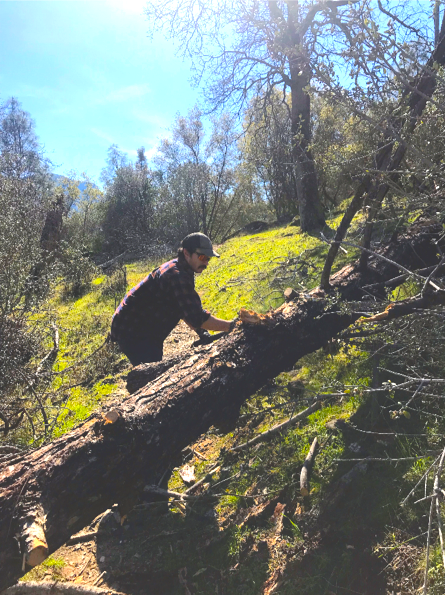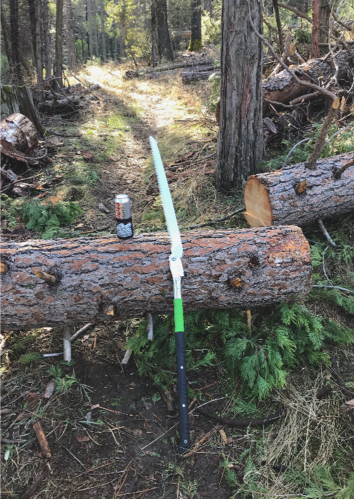We all know that Cal-Trans maintains our roads, and (for the most part) keeps the rural areas fairly neat for road cycling. If you’re riding within Fresno or Clovis city limits, you can contact the city to come out and remove debris from the bike lanes. But what happens when you ride Gravel or Mountain bikes? Who handles those trails? Well, we are lucky enough to have other local clubs and groups in the area that operate just like our Fresno Cycling Club: on a volunteer basis. “Trail advocacy” has been done locally for several years, but only on certain trails. There have been huge areas that have been neglected and left to their demise until recently. There seems to be a resurgence for taking care of our trails, and the volunteers that do that are incredible individuals worthy of a big THANK YOU!
I reached out to my good friend, Roy Flake; a man among men. He cut his teeth racing road bikes for Fresno State, SPOC, and other teams a few years back but has always had a love affair with the dirt. His insights into trail stewardship and why it’s vital to our local community are a reminder that we as cyclists can all learn and help each other be safer no matter what discipline(s) you’re into. Here’s what Roy had to say:
There are two ways up the Goat Mountain trail. One is along the saddle of the mountain, further to the south, which consists mainly of a gradual fire road climb that winds itself up to the top at a consistent grade. It’s the favored route for most riders, as it’s easy to settle in over the thirty-or-so minutes to the top. The other, more difficult route is to climb the descent starting from the back of the campground. I prefer the later. Not only do I find it more demanding and challenging, but it gives me a chance to scope the trail condition before plummeting back down to the lake. As I ascend, I’ll likely find a reason to dismount— a low hanging branch that needs trimming, clearing debris, or the (unfortunately) more common than not fallen tree that has to be cut out. Years ago, I like many would have instead remained on my bike and pedaled around the obstruction. If I had to dismount to clamber over a fallen tree, or was inconvenienced by a rutted and washed out section, I’d likely get upset and feel that my ride was interrupted. Looking back, I’m disappointed on the perspective I had. The mindset of ‘someone else will take care of it’, or the complete obliviousness of how the trail “magically” mends itself. These are often what the mind reverts to on the trail. What appears to be work though, is in actuality opportunity. We’re fortunate enough to have multiple stewardship groups here in the county, all of which do a great job of keeping out trails clear, as well as building community.
We don’t realize how fortunate we are to live so close to such epic riding. The “Big Sandy” race is renowned across the state simply because of the San Joaquin River Trail (SJRT). The course is arguably one of the most dynamic in the valley. Steep punchy climbs, loose rock gardens, and flowing single track that can surmount into a 30+ mile all day epic if one is up to it. From mid-Fall to late-Spring typically yield optimal riding conditions with lots of greenery, running creeks, and plenty of “hero dirt.” However, the cumulation of the drought a few years back, combined with heavy use has caused numerous erosion problems where ruts have formed (up to two feet in depth). Our local trail stewards, CCORC (Central California Off-Road Cyclists)are the main caretakers of the SJRT, and recently held a work day where some of the more extensive areas were addressed. These efforts are integral to keeping such a local recreational gem sustainable, and ought to be implemented by not only mountain bike clubs, but ALL recreational groups that utilize the River Trail.
Further North, and deeper in the mountains at the foot of Yosemite National Park is Bass Lake. An area locally renowned for big mountain riding at its finest, and home to some of the more technically demanding trails in the valley. It’s the perfect area for riders to flex their long travel bikes as well as their wits. Riders who choose to make the trek up to the tops of the fire look-outs are rewarded with incredible views of the Sierras, which are often surreal once the first snow of the season caps Mammoth Mountain in the distance.  The dirt is for the most part decent year-round, due to the dense pine trees shadowing the trails. Sections resemble riding up in Oregon, making you feel you’re much further from home than you likely are. Again though, the drought along with the damage of the bark beetle combined with wind storms and recent wet seasons have weakened many trees and therefore would have closed all recreation had it not been for trail stewards. The recently formed “Yosemite South Gate Trail Cooperative” have come out, guns blazing, over the past year doing their best to keep the trails open. These trails are all multi-use as well, and commonly serve as recreation for hikers and horseback riders alike.
The dirt is for the most part decent year-round, due to the dense pine trees shadowing the trails. Sections resemble riding up in Oregon, making you feel you’re much further from home than you likely are. Again though, the drought along with the damage of the bark beetle combined with wind storms and recent wet seasons have weakened many trees and therefore would have closed all recreation had it not been for trail stewards. The recently formed “Yosemite South Gate Trail Cooperative” have come out, guns blazing, over the past year doing their best to keep the trails open. These trails are all multi-use as well, and commonly serve as recreation for hikers and horseback riders alike.
Chances are, even if you’ve only been riding for a few months and are from Fresno, you’ve likely heard of if not ridden both of these areas. Although trail stewardship should pertain to all groups/clubs that utilize the trails for recreational use, we as mountain bikers have proven to be some of the most active. So how can you help and aid in the efforts to keep our trails in operable condition year-round? Firstly, join a stewardship! Not only is it an excellent way to get involved in sanctioned work days, but it’s also an incredible opportunity to meet and ride with others who are passionate about the same things.
Secondly, most riders choose to carry a hydration pack of some form. These packs not only carry a water bladder, but will likely be able to hold some essential trail tools as well.  I always carry a collapsible saw on my rides, and it’s neither cumbersome nor does it slow me down. Being able to remove small trees or limb a branch that could cause an accident is a fantastic way to be proactive on the trails— and it’s surprisingly fun! Obviously, riders must use discretion, as staying safe does supersede.
I always carry a collapsible saw on my rides, and it’s neither cumbersome nor does it slow me down. Being able to remove small trees or limb a branch that could cause an accident is a fantastic way to be proactive on the trails— and it’s surprisingly fun! Obviously, riders must use discretion, as staying safe does supersede.
Lastly, for all those with smartphones, the app “Trailforks” in my opinion is essential. Not only does it show details of the trails in your area, but also the condition they’re in as well as any issues with it. If you notice something that needs addressing and aren’t prepared enough for the work, reporting it on Trailforks allows others including stewards to be aware of it. The app also displays the group who takes care of the area you’re viewing/riding, and will likely have a donation option to help with efforts. I make it a point to always donate when riding out of town as a ‘thank you’ to the local group(s) who make it possible for me to enjoy a ride elsewhere.
It’s likely you got into mountain biking because you enjoy the outdoors, the challenge, being around like people, and are passionate about physical recreation. Being an advocate of maintaining our local trails not only encompasses these same things, but enhances the enjoyment— it’s part of the sport, whether you realize it or not. The sense of accomplishment and pride in stewardship is much more rewarding than you moving up to 32nd from 33rd on the STRAVA segment. Whether or not you join a trail group, make a point to pack a saw on your next ride, or simply donate a few dollars to the stewards. Every bit counts and will help in keeping these areas open. I’ll see you out on the trail.
-Roy B. Flake
Sustainability is the key word here. It’s true for all bike-related activities and all clubs that exist today. We have some of the best trails around, with incredible views and a wide mix of terrain. Thank you so much, Roy for your insight.
We as the Fresno Cycling Club can easily take this idea of stewardship and apply it to our own rides and groups. Should our ride leaders carry a tiny broom with them on group rides? Should we all have the FresGo App on our phones to make sure we send all necessary photos to the city for minor and serious safety issues? Should we have a club roadside clean-up day?
What can we do as a club to better our riding environment and make it safer for the new riders getting into the sport that we all love and share? I always hear about cars buzzing us, or someone cut someone off, or a construction company leaving a sign in the bike lane. Let’s face it: cycling can be dangerous at times even when we follow the rules of the road. I encourage you to think of ways that we can get together and make our routes safer and more enjoyable for all of us. Tina Sumner (559.304.6390/advocacy@fresnocycling.com) is the Advocacy Director for the club and is always looking for help and new ideas.
Please feel free to get ahold of me for any ideas or concerns.
-Devin Bovee
559.797.0148 – Devin@stevensbicycles.com
